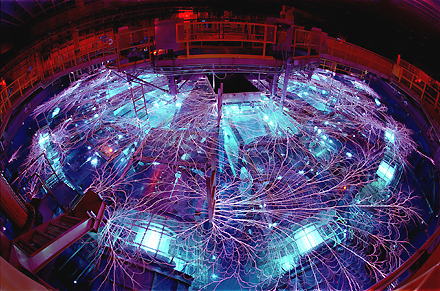In 1998, the Japanese JT-60 tokamak fusion reactor "produced a high performance reversed shear plasma with the equivalent fusion amplification factor of 1.25" which represented a world record of Q. Q represents the fusion energy gain factor. This is the ratio of fusion power produced by a fusion reactor to the amount of energy that must be expended to maintain the stability of the plasma. A Q=1 is the break-even point where there is as much energy coming out as going in. The European-based work on heavy ion fusion power systems such as HIDIF and GSI-98-06 included the use of telescoping beams of different isotopic nuclei.
In 1999, the United States ended its involvement with the International Thermonuclear Experimental Reactor (ITER). The Small Tight Aspect Ratio Tokamak in the U.K. is retired and replaced by the Mega Ampere Spherical Tokamak experiment which is still in operation today.
In 2001, the construction of the building to house the National Ignition Facility (NIF) at the Lawrence Livermore National Laboratory, begun in 1997, was completed. Work on the laser beam lines and diagnostic bays began this year. The NIF is expected to run its first full test in 2010. Negotiations begin among Canada, European, Japan and Russia on the Joint Implementation of the ITER project.
In 2002, the European Union put forward Cardarache and Vandellos as possible locations for the ITER project. The Cardarache facility in France is a scientific center dedicated to nuclear energy research. The Vandellos Nuclear Power Plant is located in the Catalonia region of Spain. Japan nominated Rokkasho as their candidate for locating the ITER project.
In 2003, the U.S. rejoined the ITER project. China and the Republic of Korea also joined the multination fusion research project. In the same year, Canada pulls out of the ITEM project. The Cardarache facility in France is chosen as the site for the construction of the ITER. Sandia National Laboratories in the U.S. begin running fusion inertial confinement fusion experiments on their Z machine also known as the Z Pulsed Power Facility. It is the biggest X-ray generator ever built. It is used to test how materials react to extremes of temperature and pressure.
In 2004, the U.S. decided that it could not equal the European fusion research progress demonstrated by the Fusion Ignition Research Experiment (FIRE) on its own. The U.S. concluded that it would be best to fully support the ITER project.
In 2005, final negotiations between the E.U. and Japan result in the selection of Cardarache as the site for the construction of the ITER. Japan is allowed to host a related research facility and to name twenty percent of the staff for ITER although it is only providing ten percent of the funding. The NIF test fires a bundle of eight laser beams and achieves the biggest energy laser pulse of one hundred fifty two kiloJoules in the infrared part of the EM spectrum.
The Sandia Z-Machine:
